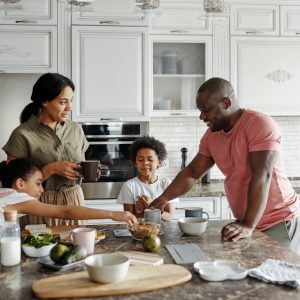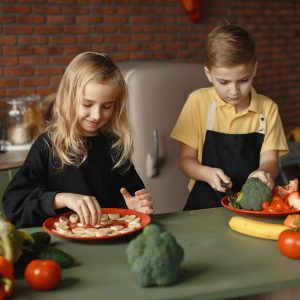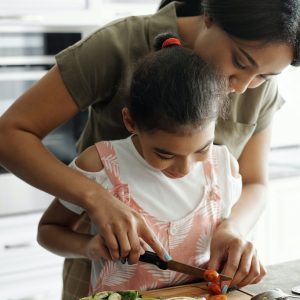Cooking with kids
We’ve talked a fair amount about cooking with kids as a positive way to enhance their feelings of relatedness, increase their competence in the kitchen, and help them to become life-long healthy eaters. Easier said than done, right? You’re probably imagining a huge mess and cooking taking twice as long when everyone just wants dinner on the table, and in truth, that might happen sometimes! But in this post, we’re going to talk about the HOW of cooking with kids- how to prepare, how to keep it age- appropriate, how to keep kids safe in the kitchen, and more. We’re going to help you learn to cook with kids in a way that keeps them engaged and excited about healthy eating and isn’t a lot of stress for you!
Timing is Everything:

First and foremost, if you’re going to cook a meal with kids, start by picking a time that works for you- and starting earlier than you normally would when cooking that same meal on your own. You might want to try a weekend afternoon when you’re not feeling rushed, rather than a crazy weeknight when the whole family is busy and you’re trying to get food on the table as fast as possible.
Also, consider timing with the cooking itself. Make sure that what you’re cooking doesn’t have a ton of time-sensitive steps that need to be prepared just-so. Try an easier dish that doesn’t have too many ingredients and doesn’t need to be completed quickly!
Prepare for mess:
Let’s be honest: kids are messy! But if you plan ahead, you can let kids be kids, and still make clean-up much simpler. Set down newspaper or an old tablecloth at a station where kids will be helping. Don’t forget to put kids in clothes you don’t mind them spilling on- or use aprons!
Break down responsibilities by age:

Start by picking a recipe that’s kid-friendly. Something like pizzas with different toppings that kids can pick and choose from, or wraps/sandwiches. Once you’ve picked a recipe, give kids age-appropriate tasks to do:
- Toddlers: Don’t discount toddlers! Starting kids early with handling food can have big benefits. Keep a watchful eye on your toddler, and have them do simple tactile things, like rinsing vegetables, stirring cold ingredients, and sprinkling in ingredients like flour or spices (that you have measured).
- Preschoolers: Preschoolers can continue to do some of the tasks that were good for toddlers- and usually with a bit more confidence and accuracy! Have them wash beans, fruit, and vegetables, knead dough, or pour ingredients into a bowl.
- School-age children: As children get older (and more comfortable in the kitchen) they can take on more difficult tasks. School-age children may be ready for things like measuring or weighing ingredients, peeling oranges or eggs, cutting ingredients using a small knife (with supervision!), setting the table, and reading ingredients out loud.
Remember: Safety & sanitation

Working in the kitchen with little ones is the perfect opportunity to teach them about kitchen safety and cleanliness. Make sure they wash their hands before getting started, and right after touching any raw meat, eggs, or flour. While cooking, continue to remind kids about something being hot, or cold, and what could hurt them. It also helps to have some kitchen rules, such as always washing hands, not touching knobs on the stove or oven, never touching knives without asking, and so on. Talking to kids about the kitchen helps them learn their way around it- and helps them become more confident and competent!
Last but not least- Have fun!
Cooking with your kid can not only help them eat better and enjoy cooking, it’s a great experience for you to enjoy together, and a great way to spend some quality time with one another. Having fun in the kitchen might just be the most important part of cooking together. You might even start a new family ritual. And who knows, maybe someday soon your child will be the one cooking dinner!